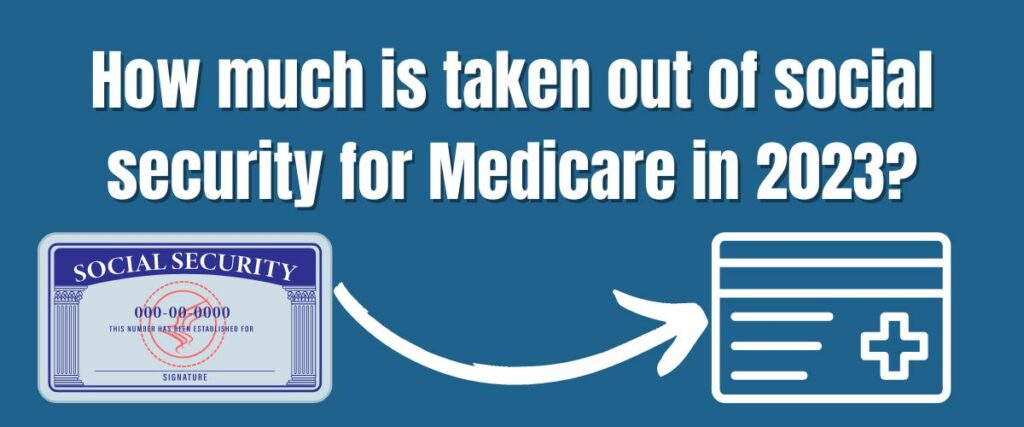How much is taken out of social security for Medicare in 2023?
Understanding Medicare premium deductions from Social Security requires unraveling some complexities. In 2023, the standard monthly Part B premium will be $164.90 for most people. However, higher earners get hit with larger amounts based on income tiers that raise rates through IRMAA. Having Part D prescription or Medicare Advantage coverage also increases deductions. For those receiving Social Security, these costs come straight from benefit checks automatically.
For example, someone with a $1,500 monthly Social Security payment may see around $1,335 after the basic $164.90 Part B premium deduction is applied. Tacking on a $50 Part D premium could reduce it further to about $1,285. Those unable to afford premiums may qualify for assistance through Medicaid and Medicare Savings Programs depending on their situation.
Knowing your exact Medicare deduction amount from Social Security is vital for accurate budgeting. Carefully review statements from the Social Security Administration and follow up on any questions. While complicated, resources exist to help decode Medicare.
The Different Parts of Medicare
Medicare coverage includes a few core components:
Part A covers hospital inpatient stays, skilled nursing facilities, hospice, and some home health services. Most people don’t pay premiums for Part A.
Part B includes doctor visits, outpatient care, preventive services, durable medical equipment, and more. Most people pay monthly premiums for Part B coverage.
Medicare Part C, or Medicare Advantage, are private plan options that offer Parts A and B benefits plus additional coverage.
Part D provides prescription drug coverage through private insurance plans. Monthly premiums apply for Part D.
How Income Affects Medicare Part B Premiums in 2023
The standard Part B premium is set at $164.90 per month for 2023. However, income determines whether you pay the base rate or higher premiums.
Medicare uses your reported income from 2 years prior to calculate yearly Part B premiums through monthly adjusted gross income.
Here’s how 2023 Part B premiums break down by income for individuals:
– Under $97,000 – $164.90 monthly
– $97,000-$123,000 – $230.80 monthly
– $123,000-$153,000 – $329.70 monthly
– $153,000-$183,000 – $428.60 monthly
– Over $183,000 – $506.90 monthly
And here are the income brackets for married couples filing jointly:
– Under $194,000 – $164.90 monthly
– $194,000-$242,000 – $230.80 monthly
– $242,000-$302,000 – $329.70 monthly
– $302,000-$365,000 – $428.60 monthly
– Over $365,000 – $506.90 monthly
So higher earners pay more for their Part B coverage. The maximum monthly Part B premium for 2023 is $506.90 per person.
Medicare Premiums Deducted from Social Security Payments
If you currently receive Social Security retirement benefits, Railroad Retirement benefits, or Social Security disability benefits, your Medicare Part B premiums will be automatically deducted from your monthly payments.
Each year, the Social Security Administration notifies you of your new benefit amount after deducting your updated Medicare premiums. They deduct premium costs for both Part B and Part D coverage if you have a stand-alone prescription drug plan.
For example, if your monthly Social Security benefit is $1,500 and your Part B premium is the standard $164.90 in 2023, your adjusted Social Security payment would be $1,335.10 after Medicare deductions are applied.
If you also have a Part D Plan with a $50 monthly premium, your total Medicare deductions would be $214.90, making your adjusted Social Security payment $1,285.10.
The amounts deducted from their Social Security check don’t go directly to Medicare itself. Rather, the deductions help cover the overall benefits you receive through the Medicare program. Social Security and Medicare work together to provide you with great medical coverage. So long as you’ve paid Medicare taxes and annual deductibles, you receive optimal cover.
Paying Premiums Without Social Security Check
If you have Medicare coverage but don’t receive Social Security or Railroad Retirement Board benefits, your Medicare premiums won’t be automatically deducted from payments each month. Instead, you’ll get a bill directly from Medicare that you’ll need to pay yourself.
Here are some options for paying Medicare premiums if they aren’t deducted from Social Security:
– Pay your monthly Medicare bill online, by phone, or by mail through your Medicare account.
– Sign up for auto-bill pay through your bank account.
– If you have a Medicare Advantage or Part D Plan, you may be able to arrange premium deductions from your checking or savings account.
– Some people choose to pre-pay their Medicare premiums quarterly or annually instead of monthly.
No matter how you pay, it’s essential to keep your Medicare premium payments current in order to avoid losing coverage.
Medicare Advantage Premiums
If you’re enrolled in a Medicare Advantage Plan for your Part C coverage instead of Original Medicare, your premiums and deductibles will be different. Medicare Advantage Plans are offered by private insurance companies approved by Medicare.
Medicare Advantage Plans have annual out-of-pocket spending limits, which Original Medicare does not. They also frequently include prescription drug coverage and additional benefits not covered by Original Medicare.
Each Medicare Advantage insurer sets its own monthly premiums for their plans, which affects how much you’ll pay. On average, Medicare Advantage premiums for 2023 are around $50 per month. However, actual plan premiums vary significantly and can range from $0 up to over $200 monthly.
Just as with Part B premiums, Medicare Advantage premiums are also affected by IRMAA adjustments based on your income. Higher earners will pay more for their Medicare Advantage coverage.
Unless you arrange to have premiums deducted from Social Security, your Medicare Advantage Plan will bill you directly. Even if you do that, you’ll likely owe an additional amount each month beyond what’s deducted.
For example, if your plan’s premium is $75 but only the standard $164.90 Part B rate is deducted from your check, you would still need to pay the plan the additional $75 monthly cost.
Who Qualifies for Help with Medicare Costs?
Some Medicare beneficiaries qualify for assistance programs that help cover Medicare premiums, out-of-pocket costs, and prescription drug expenses:
- Medicaid – Covers Medicare premiums and cost-sharing for people with limited income and assets. Rules for eligibility differ by state.
- Medicare Savings Programs – Help pay Medicare Part B premiums for people meeting income and resource requirements. You can qualify even if you don’t meet thresholds for full Medicaid benefits.
- Extra Help – Provided by Social Security to lower prescription drug costs for limited income Medicare beneficiaries. Can substantially reduce or eliminate your Part D premiums and expenses.
To find out if you may be eligible for any of these programs, contact your local Medicaid office or Social Security office. You can also apply online through the website www.benefits.gov.
What Will Be Deducted from Social Security Each Month?
In summary, the amount deducted from your Social Security benefits each month for Medicare in 2023 depends on these key factors:
- Your income, which affects the income-related premium adjustments
- Whether you have just Part B coverage or also Part D
- If you have Original Medicare only or are enrolled in a Medicare Advantage Plan
Here are some examples to give you an idea of potential monthly deduction amounts:
- With just Original Medicare Part B – Around $165
- With Part B plus Part D drug coverage – Around $215
- With a Medicare Advantage Plan and Part B – Around $240 or more
- With higher income placing you into a bracket with a $329.70 Part B premium – Around $330 or more if you also have Part D
The total amount taken out of your Social Security payment for Medicare can vary widely, but is generally between $165 and $500 per month depending on your coverage situation. Contact the Social Security Administration if you need help confirming exactly how much will come out of your specific Social Security check for Medicare.
Contacting the SSA About Medicare Deductions
Each year, the Social Security Administration sends out letters to Medicare beneficiaries informing them of what their Medicare premiums will be for the upcoming year. The letters also provide an estimate of how much will be deducted from your Social Security payments.
If you have any questions about what your Medicare deductions will be or want to find out the exact amount that will come out of your specific Social Security check, you can:
- Call the SSA at 1-800-772-1213
- Contact your local Social Security office in person
- Check your online Social Security account for benefit details and deductions
- Carefully review the annual cost-of-living adjustment (COLA) letter you receive from Social Security
- Notify the SSA immediately if your income situation changes
Staying on top of your Medicare deductions each month and closely reviewing any letters from Social Security can help ensure you know what to anticipate financially.
Preparing for New Medicare Deductions
If you’ll soon be turning 65 and enrolling in Medicare for the first time, while also applying for Social Security retirement benefits, here are some tips to prepare for the process:
- Review the income brackets for IRMAA to estimate whether you’ll pay standard premiums or higher rates
- Understand that you’ll be automatically enrolled in Medicare Part B unless you decline it
- Know that Medicare Part A usually has no monthly premium cost
- Shop around for the best Part D prescription drug plan to fit your medications
- Consider either Medigap or Medicare Advantage Plans to supplement your coverage
- Be aware your premium costs will be retroactive if you retire and enroll mid-year
- Plan the timing of your retirement carefully with Medicare and Social Security enrollment periods in mind
- Consult with a Medicare specialist if you need help evaluating your options
Doing your homework on how Medicare coordinates with Social Security can help ensure a smoother transition when you first go to enroll.
Why Medicare Costs Can Be Confusing
Medicare enrollment choices, coverage options, premium rules and costs can be extremely complicated and confusing, especially for those new to the program. The system is not always intuitive or easy to navigate.
Be sure to take time to do extensive research so you understand all the intricacies of Medicare coverage. Reach out to free counseling resources like your State Health Insurance Assistance Program (SHIP) for unbiased support.
The more knowledge you can gain about how Medicare works in tandem with Social Security retirement benefits, the better prepared you’ll be to make smart decisions about your coverage. While complex, resources exist to provide information and help.
We’re Here to Help
You do not have to spend hours reading articles on the internet to get answers to your Medicare questions. Give Scott Sims at Sims Insurance Medicare Plans a Call at (541) 915-0939. You will get the answers you seek in a matter of minutes, with no pressure and no sales pitch. We are truly here to help.


